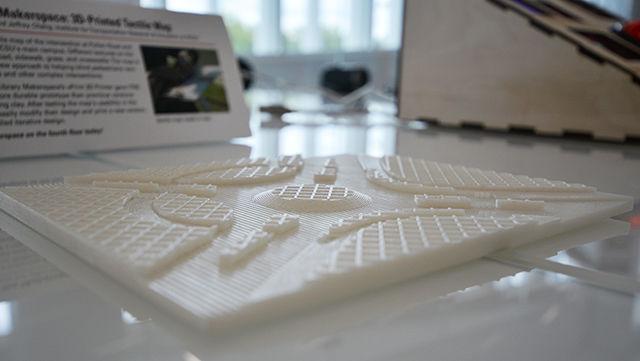 A model of a 3-D printed tactile map created by assistant director of the Institute for Transportation Research and Education, Bastian Schroeder, and Post Baccalaurate Studies major, Jeffrey Chang is on display at the James B. Hunt Library. " />
A model of a 3-D printed tactile map created by assistant director of the Institute for Transportation Research and Education, Bastian Schroeder, and Post Baccalaurate Studies major, Jeffrey Chang is on display at the James B. Hunt Library. " />
Sam Feldstein
A model of a 3-D printed tactile map created by assistant director of the Institute for Transportation Research and Education, Bastian Schroeder, and Post Baccalaurate Studies major, Jeffrey Chang is on display at the James B. Hunt Library.
A team of NC State researchers created a tactile map for blind people depicting the roundabout at Stinson Drive and Pullen Road adjacent to the Bell Tower.
The map was created by Bastian Schroeder, assistant director for highway programs at the NC State Institute for Transportation Research, and research assistant Jeffrey Chang using Hunt Library’s 3-D printer in Makerspace, an area on the fourth floor of Hunt with two 3-D printers and a laser cutter.
The intersection at Stinson and Pullen currently has no traffic lights. Unlike many other crosswalks around campus, the roundabout also has no audible indicator or crossing device to alert students to walk.
The tactile map, currently on display on the second floor of Hunt Library alongside many other 3-D printed objects, serves as a teaching tool for the blind. There are currently no plans to place the map anywhere near the roundabout.
“The maps are teaching and training tools rather than infrastructure equipment,” Schroeder said. “We will use them for research and lessons to try to explain the concept of a roundabout and how people can utilize it.”
“Tactile maps help the blind travel more, and it can also be used for rehab and mobility specialists. To explain a roundabout would be difficult without it.”
This research is not a new concept for Schroeder and his team.
“We have been involved in roundabout extension research for 15 years, so it is longstanding and has been around for many years,” Schroeder said. “This tactile map was a little bit of a process that took a couple of months to process through various prototypes.”
Makerspace at Hunt library has made it relatively simple and cost-efficient to 3-D print materials, Schroeder said.
Before 3-D printing was readily available, a tactile map would have to be created by another company off campus.
“Before it was difficult to create custom maps but the 3-D printer at Hunt allowed us to design this model and get it out faster,” Schroeder said. “Potentially this is a big application for others to use and create maps.”
According to Schroeder, the problem with tactile maps is the difficulty in customizing, but 3-D printing has become so cheap that it is easier to attain materials.
Using 3-D printing technology isn’t just unique to NC State, Schroeder said.
“There are some Wake County public schools that are starting to use 3-D printing to help blind students,” Schroeder said.
“There is a blind student at NC State who has explored 3-D printing technology and his group has been able to download a sample 3-D model. One of the students used the printer to create a representation of DNA’s double helix that he could not find before.”
Students who have seen the tactile map representation as well as other 3-D printing objects displayed at Hunt are nonetheless impressed.
“It is pretty cool. I really didn’t know much about how 3-D printers work until I saw this display,” said Asia Edwards, a freshman at UNC-Wilmington and visitor to NC State. “This [tactile map] would be great if displayed outside.”